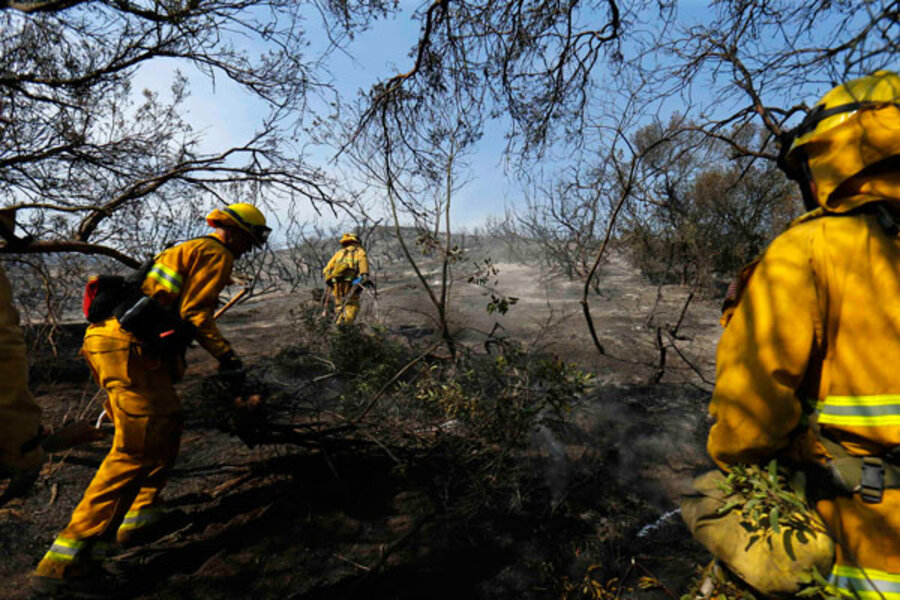How prepared is California for potentially severe fire season?
Loading...
| Los Angeles
The nine fires that swept through San Diego County last week offered a firsthand look at the progress California has made over the past decade in wildfire preparedness – as well as the challenges that remain.
Both the state and the county have learned many of the lessons from recent Western wildfires, experts say. But this fire season could be severe, with high temperatures and drought prevailing in California. Moreover, some critics say San Diego – one of the most fire-prone regions of the state – lags other counties in its fire prevention measures.
The stakes to get fire preparations right are rising, and California is on the front line.
“Until we are able to successfully address the causes of these long and extreme droughts, we need to do what we can to mitigate their effects by planning in advance and taking precautionary measures,” says Dominik Kulakowski, an associate professor in the Geography Department at Clark University in Worcester, Mass. “There is every indication that these long and extreme fire seasons are becoming more common.”
What California and many of its localities have done right is learn how to work together.
“We have learned some things from past conflagrations – most important has been an increase in the coordination of local, state, and federal agencies on the ground,” says Char Miller, professor of environmental analysis at Pomona College in Claremont, Calif.
This includes figuring how to position fire crews when the seasonal – and totally predictable – Santa Ana winds begin each year in early spring.
“After major conflagrations in 2003, 2007, and 2009, and now this, we know the drill,” adds Robert Taylor, a fire ecologist for the National Park Service.
Gov. Jerry Brown (D) and the state legislature have been very supportive, says Dennis Mathisen, spokesman for the California Department of Forestry and Fire (Cal Fire). On Tuesday, Governor Brown revised his budget to give Cal Fire an additional $66 million, allowing the department to retain the seasonal firefighters it has hired, including 300 last month.
The state has also ramped up efforts help residents understand how vital their participation is – from not starting fires to mitigating fire risks on their property to developing escape plans. New building codes are also coming into effect, with 100-foot brush-clearance requirements around homes. (Before 2003, it was 30 feet.)
“Public education campaigns on how to protect our homes from wildfire by creating defensible space, using fire-resistant materials, and so on are succeeding,” says Professor Kulakowski. “The message is slowly getting out that homeowners can do as much, or more, to protect their homes than can firefighters.”
Much of this progress was on display during the San Diego fires last week.
“Ten years ago, we were still a very disjointed group of fire departments,” Cal Fire Assistant Region Chief Thom Porter told the San Diego Union-Tribune.
Today, “we are working hand and glove,” he added. “We know each others’ strengths and weaknesses, and we are complementing each other.”
Indeed, the Emergency Operations Center that acted as the headquarters for the firefighting operations last week essentially didn’t exist during the devastating Cedar Fire in 2003. In 2008, San Diego also created the County Fire Authority to consolidate agencies and coordinate wildfire protection.
But some experts say those efforts do not go far enough, blaming county taxpayers for refusing to add fees that would boost local firefighting capacity. Others say political leaders have not provided taxpayers with a plan worth supporting.
San Diego stands out as “easily one of the least prepared [counties] in the entire country,” says Richard Halsey, president of the California Chaparral Institute in Escondido.
Though he calls the taxpayers “stingy,” he says a Proposition A, a 2008 ballot initiative aimed at addressing San Diego’s fire preparation, was so poorly written that even he and a well-known fire chief voted against it.
Prop. A would have assessed a $52 parcel tax on residents for fire protection services. It was “great politics, but lousy policy,” Halsey wrote in an opinion article at the time.
He argued that it overlooked the urgent need: creating a regional fire department.
San Diego County Supervisor Dianne Jacob counters that many local taxpayers already pay a significant amount in wildfire-related fees and that San Diego has made important strides.
“While [Proposition A] failed in 2008 at the ballot box, many residents tax themselves each year through fire assessment districts in our most wildfire-prone areas,” she says, noting that nearly $12 million was collected last year within these special districts.
Backcountry residents pay an average of $198 per parcel in extra fire fees each year on top of their regular property taxes, she adds.
Since 2003, San Diego County has spent more than $285 million on new firefighting equipment, fire station upgrades, better communications, and other improvements, she adds.
Data compiled by her office suggest progress. The number of homes lost per acres burned in recent wildfires has steadily declined, from one home for every 183 acres in 2003, to one for every 230 acres in 2007, to one for every 587 acres this year. And this year’s fires were in comparatively more densely populated areas.
“Last week, during the height of our fires, we saw those investments pay off in a big way,” Ms. Jacob says.
But without raising taxes further to add manpower, Professor Miller worries that San Diego will be overly reliant on other counties to help fight its fires.
“San Diego County’s astonishing lack of professional firefighting units … means they are off-loading their responsibilities on other taxpayers across the state who pay to protect them and to protect them in landscapes that are fire-prone, fire-created.”
[Editor's note: This article has been revised to include additional information not in the original.]







